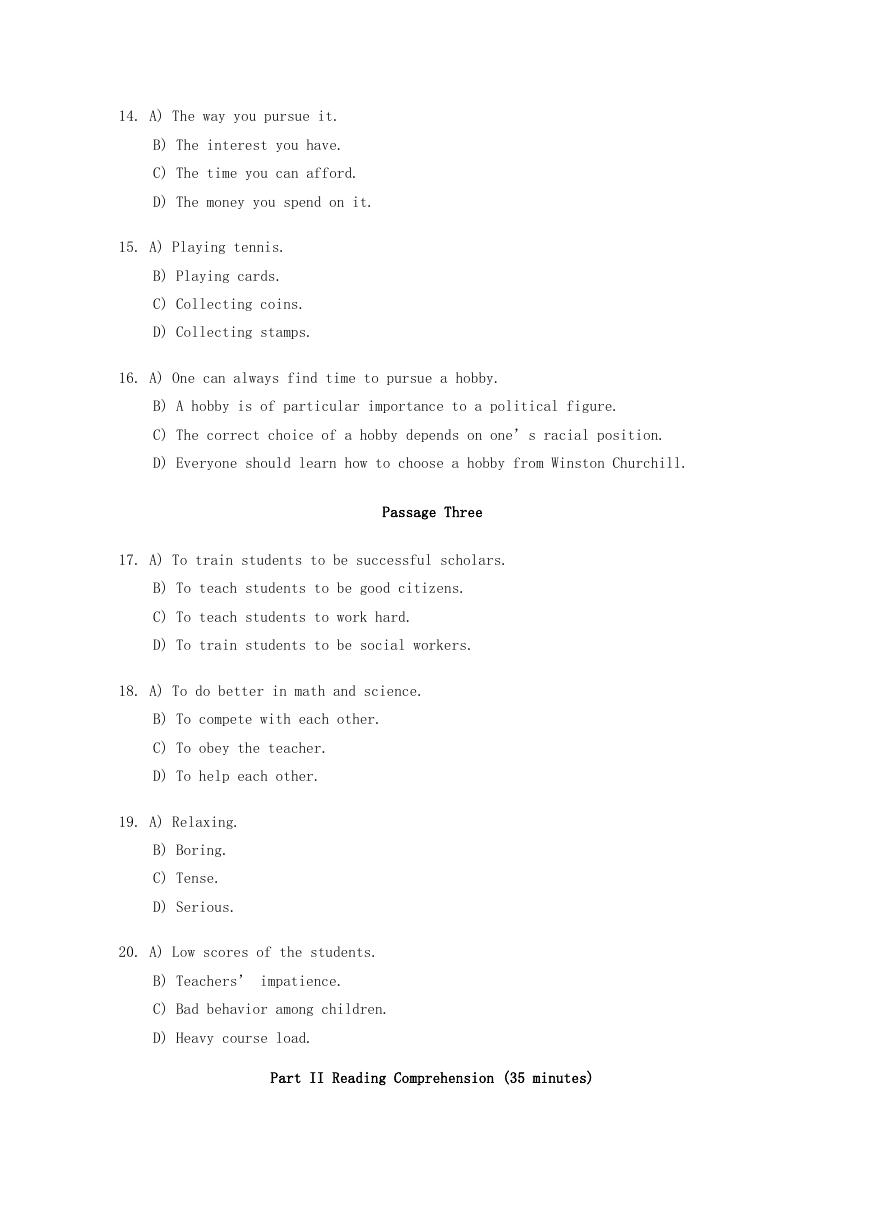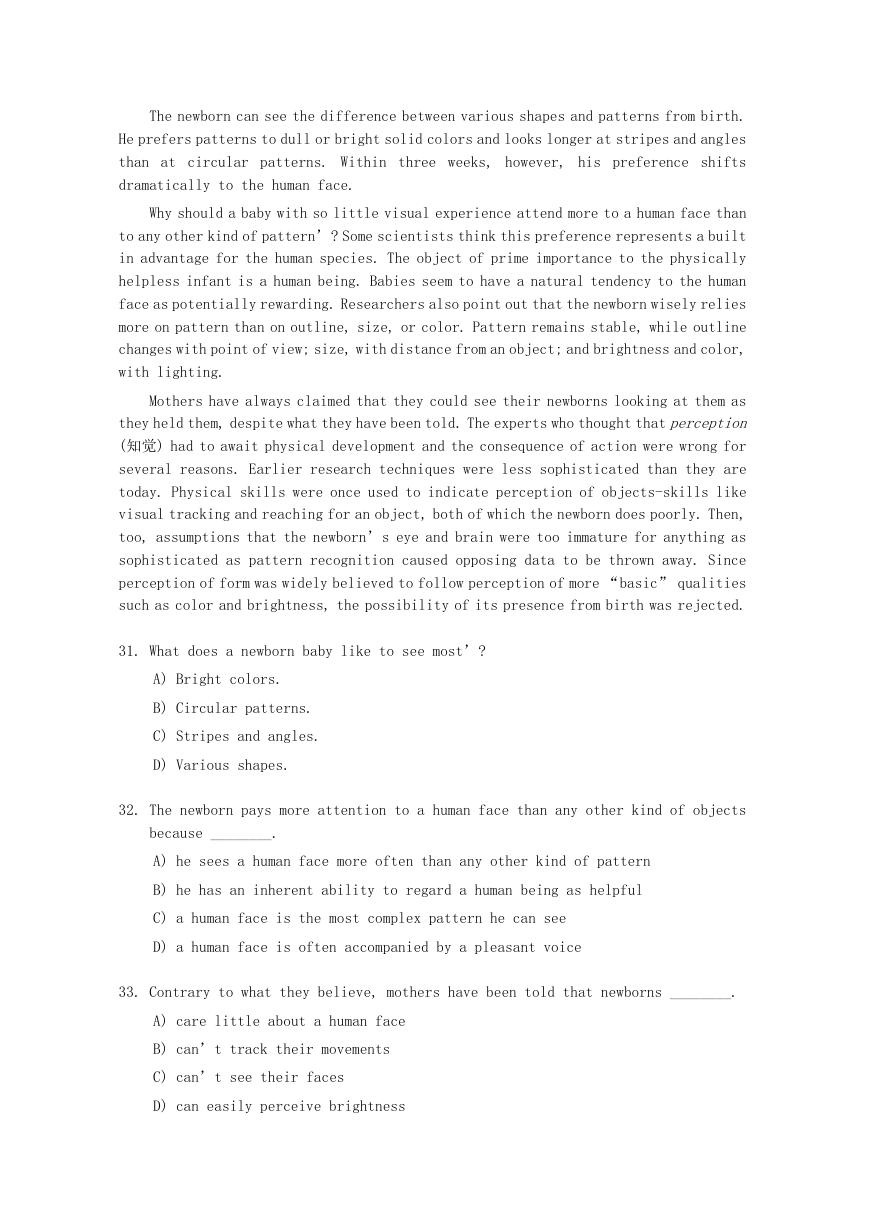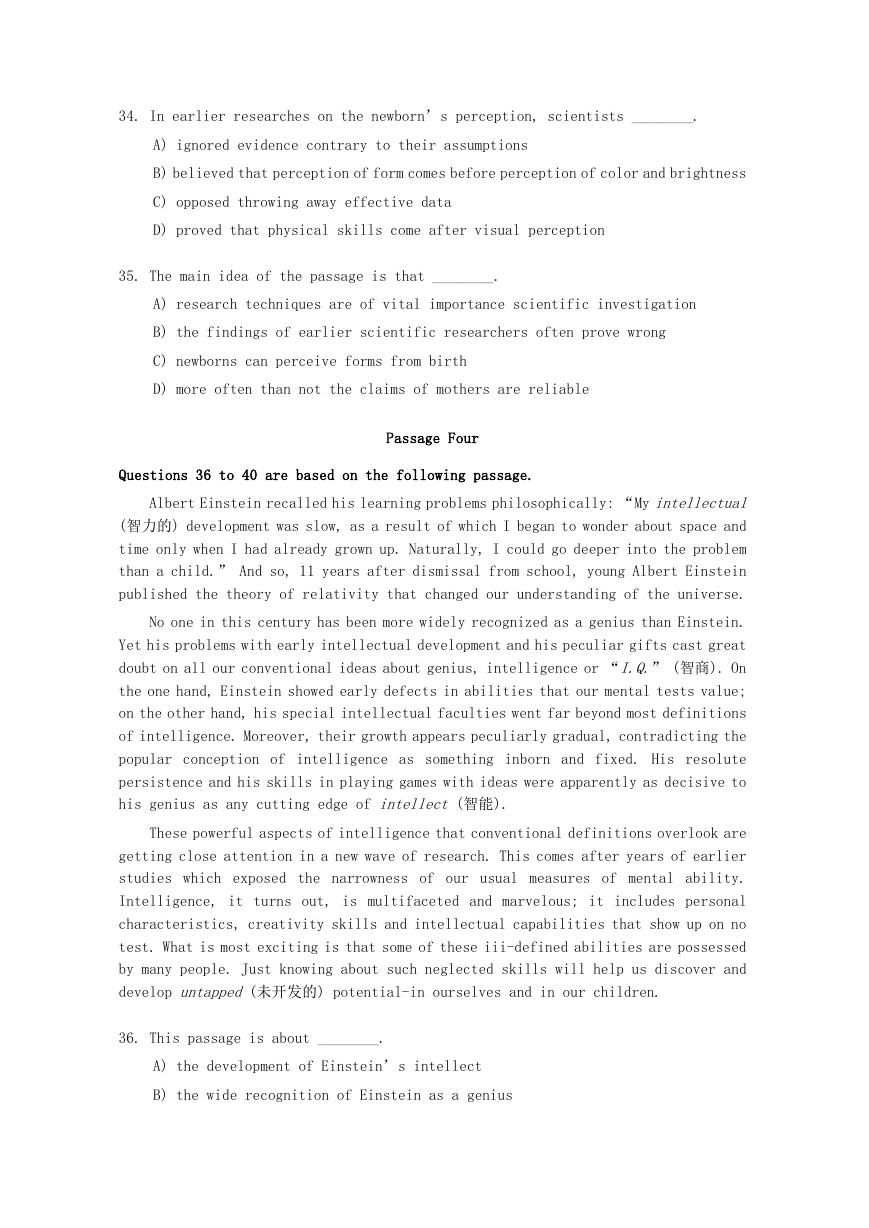1991 年 1 月英语六级真题及答案
Part I Listening Comprehension (20 minutes)
Section A
1.
A) Excited.
B) Pleased.
C) Moved.
D) Disappointed.
2.
A) She hasn’t been well lately.
B) She wants a technician to repair it.
C) She feels unhappy without the TV set.
D) She wants him to fix it at once.
3.
A) He often complains about his job.
B) He is not interested in office work.
C) He likes his job very much.
D) He does mind all the overtime.
4.
A) Her mother did her hair.
B) She inherited it.
C) Her mother designed.
D) Her hair is modeled.
5.
A) Allen does twice as much work as the rest.
B) Allen will do the assignment in two hours.
C) Allen is very careless with his homework.
D) Allen works twice as fast as the rest.
6.
A) The man is looking for a book.
B) The woman is a librarian.
C) The book was of little help to the man.
D) The book was of great help to the man.
7.
A) 6.
B) 15.
�
C) 14.
D) 29.
8.
A) Maybe the invitation was too late.
B) The man’s wife didn’t invite Margaret.
C) Margaret promised to come, but later she changed her mind.
D) Margaret will come any moment.
9.
A) To go to bed.
B) To check her family expenses.
C) To stay upstairs.
D) To rest for a while.
10. A) John is usually late.
B) John will not show up.
C) John will be there at eight-thirty.
D) John is usually on time.
Section B
Passage One
11. A) Some piano pieces.
B) Songs sung by African singers.
C) A new kind of music.
D) Music from different parts of the world.
12. A) Tenderness.
B) Happiness.
C) Love.
D) Sadness.
13. A) How much people like sad music.
B) Why music is an important form of art.
C) How music expresses people’s feelings.
D) In what way classic music differs from pop music.
Passage Two
�
14. A) The way you pursue it.
B) The interest you have.
C) The time you can afford.
D) The money you spend on it.
15. A) Playing tennis.
B) Playing cards.
C) Collecting coins.
D) Collecting stamps.
16. A) One can always find time to pursue a hobby.
B) A hobby is of particular importance to a political figure.
C) The correct choice of a hobby depends on one’s racial position.
D) Everyone should learn how to choose a hobby from Winston Churchill.
Passage Three
17. A) To train students to be successful scholars.
B) To teach students to be good citizens.
C) To teach students to work hard.
D) To train students to be social workers.
18. A) To do better in math and science.
B) To compete with each other.
C) To obey the teacher.
D) To help each other.
19. A) Relaxing.
B) Boring.
C) Tense.
D) Serious.
20. A) Low scores of the students.
B) Teachers’ impatience.
C) Bad behavior among children.
D) Heavy course load.
Part II Reading Comprehension (35 minutes)
�
Passage One
Merchant and passenger ships are generally required to have a life preserver for
every person aboard and, in many cases, a certain percentage of smaller sizes for
children. According to United States Coast Guard requirements, life preservers must
be simple in design, reversible, capable of being quickly adjusted to fit the
uninitiated individual, and must be so designed as to support the wearer in the water
in an upright or slightly backward position.
Sufficient buoyancy (浮力) to support the wearer should be retained by the life
preserver after 48 hour in the water, and it should be reliable even after long period
of storage. Thus it should be made of materials resistant to sunlight, gasoline, and
oils, and it should be not easily set on fire.
The position in which the life preserver will support a person who jumps or falls
into the water is most important, as is its tendency to turn the wearer in the water
from a face-down position to an upright or slightly backward position, with his face
clear of the water, even when the wearer is exhausted or unconscious.
The method of adjustment to the body should be simple, and self-evident to
uninitiated persons even in the dark under the confused conditions which follow a
disaster. Thus, the life preserver should be reversible, so that it is nearly impossible
to set it on wrong. Catches, straps, and ties should be kept to a minimum. In addition,
the life preserver must be adjustable to the wide variety of shapes and sizes of wearers,
since this greatly affects the position of floating and the self-righting qualities.
A suitable life preserver should also be comfortable to wear at all times, in and out
of the water, not so heavy as to encourage to take it off on shipboard while the ship
is in danger, nor so burdensome that it hinders a person in the water while trying to
swim.
21. The passage is mainly about ________.
A) the uses of life preservers
B) the design of life preservers
C) the materials for life preservers
D) the buoyancy of life preservers
22. According to the passage, a life preserver should be first of all, ________.
A) adjustable
B) comfortable
C) self-evident
D) self-righting
23. United States Coast Guard does NOT require the life preserver to the made ________.
A) with as few strings as possible
B) capable of being worn on both sides
�
C) according to each wearer’s size
D) comfortable and light to wear
24. By “the uninitiated individual” (Para. 1, line 6) the author refers to the person
________.
A) who has not been instructed how to use a life preserver
B) who has a little experience in using a life preserver
C) who uses a life preserver without permission
D) who becomes nervous before a disaster
25. What would happen if a person were supported by the life preserver in a wrong
position?
A) The waves would move him backwards.
B) The water would choke him.
C) He would immediately sink to the bottom.
D) He would be exhausted or unconscious.
Passage Two
A hundred years ago it was assumed and scientifically “proved” by economists that
the laws of society made it necessary to have a vast army of poor and jobless people
in order to keep the economy going. Today, hardly anybody would dare to voice this
principle. It is generally accepted that nobody should be excluded from the wealth
Western industrialized countries, a system of insurance has been introduced which
guarantees everyone a minimum of subsistence (生活维持费) in case of unemployment,
sickness and old age. I would go one step further and argue that, even if these conditions
are not present, everyone has the right to receive the means to subsist (维持生活),
in other words, he can claim this subsistence minimum without having to have any
“reason”. I would suggest, however, that it should be limited to a definite period
of time, let’s say two years, so as to avoid the encouraging of an abnormal attitude
which refused any kind of social obligation.
This may sound like a fantastic proposal, but so, I think, our insurance system
would have sounded to people a hundred years ago. The main objection to such a scheme
would be that if each person were entitled to receive minimum support, people would
not work. This assumption rests on the fallacy of the inherent laziness in human nature,
actually, aside from abnormally lazy people, there would be very few who would not want
to earn more than the minimum, and who would prefer to do nothing rather than work.
However, the suspicions against a system of guaranteed subsistence minimum are not
groundless, from the standpoint of those who want to use ownership of capital for the
purpose of forcing others to accept the work conditions they offer. If nobody were forced
to accept work in order not to starve, work would have to be sufficiently interesting
and attractive to induce one to accept it. Freedom of contract is possible only if both
�
parties are free to accept and reject it; in the present capitalist system this is not
the case.
But such a system would not only be the beginning of real freedom of contract between
employers and employees, its principal advantage would be the improvement of freedom
in inter-personal relationships in every sphere of daily life.
26. People used to think that poverty and unemployment were due to ________.
A) the slow development of the economy
B) the poor and jobless people’s own faults
C) the lack of responsibility on the part of society
D) the large number of people who were not well-educated
27. Now it is widely accepted that ________.
A) the present system of social insurance should be improved
B) everybody should be granted a minimum of subsistence without any “reason”
C) everybody has the right to share in the wealth of the country
D) people have to change their attitude towards the poor
28. The writer argues that a system of social insurance should ________.
A) provide benefits for the sick, old and unemployed
B) encourage people to take on more social obligations
C) guarantee everyone the right to be employed
D) provide everyone with the right to a minimum subsistence for a certain period
29. The word “fallacy” (Para. 2. L. 6) means ________.
A) doubt
B) fact
C) strong argument
D) wrong belief
30. According to the writer, a system of guaranteed subsistence minimum ________.
A) demands too much from society
B) makes freedom of contract impossible
C) helps people take interest in their work
D) helps bring about changes in the relationship among people
Questions 31 to 35 are based on the following passage.
Passage Three
�
The newborn can see the difference between various shapes and patterns from birth.
He prefers patterns to dull or bright solid colors and looks longer at stripes and angles
than at circular patterns. Within three weeks, however, his preference shifts
dramatically to the human face.
Why should a baby with so little visual experience attend more to a human face than
to any other kind of pattern’? Some scientists think this preference represents a built
in advantage for the human species. The object of prime importance to the physically
helpless infant is a human being. Babies seem to have a natural tendency to the human
face as potentially rewarding. Researchers also point out that the newborn wisely relies
more on pattern than on outline, size, or color. Pattern remains stable, while outline
changes with point of view; size, with distance from an object; and brightness and color,
with lighting.
Mothers have always claimed that they could see their newborns looking at them as
they held them, despite what they have been told. The experts who thought that perception
(知觉) had to await physical development and the consequence of action were wrong for
several reasons. Earlier research techniques were less sophisticated than they are
today. Physical skills were once used to indicate perception of objects-skills like
visual tracking and reaching for an object, both of which the newborn does poorly. Then,
too, assumptions that the newborn’s eye and brain were too immature for anything as
sophisticated as pattern recognition caused opposing data to be thrown away. Since
perception of form was widely believed to follow perception of more “basic” qualities
such as color and brightness, the possibility of its presence from birth was rejected.
31. What does a newborn baby like to see most’?
A) Bright colors.
B) Circular patterns.
C) Stripes and angles.
D) Various shapes.
32. The newborn pays more attention to a human face than any other kind of objects
because ________.
A) he sees a human face more often than any other kind of pattern
B) he has an inherent ability to regard a human being as helpful
C) a human face is the most complex pattern he can see
D) a human face is often accompanied by a pleasant voice
33. Contrary to what they believe, mothers have been told that newborns ________.
A) care little about a human face
B) can’t track their movements
C) can’t see their faces
D) can easily perceive brightness
�
34. In earlier researches on the newborn’s perception, scientists ________.
A) ignored evidence contrary to their assumptions
B) believed that perception of form comes before perception of color and brightness
C) opposed throwing away effective data
D) proved that physical skills come after visual perception
35. The main idea of the passage is that ________.
A) research techniques are of vital importance scientific investigation
B) the findings of earlier scientific researchers often prove wrong
C) newborns can perceive forms from birth
D) more often than not the claims of mothers are reliable
Passage Four
Questions 36 to 40 are based on the following passage.
Albert Einstein recalled his learning problems philosophically: “My intellectual
(智力的) development was slow, as a result of which I began to wonder about space and
time only when I had already grown up. Naturally, I could go deeper into the problem
than a child.” And so, 11 years after dismissal from school, young Albert Einstein
published the theory of relativity that changed our understanding of the universe.
No one in this century has been more widely recognized as a genius than Einstein.
Yet his problems with early intellectual development and his peculiar gifts cast great
doubt on all our conventional ideas about genius, intelligence or “I.Q.” (智商). On
the one hand, Einstein showed early defects in abilities that our mental tests value;
on the other hand, his special intellectual faculties went far beyond most definitions
of intelligence. Moreover, their growth appears peculiarly gradual, contradicting the
popular conception of intelligence as something inborn and fixed. His resolute
persistence and his skills in playing games with ideas were apparently as decisive to
his genius as any cutting edge of intellect (智能).
These powerful aspects of intelligence that conventional definitions overlook are
getting close attention in a new wave of research. This comes after years of earlier
studies which exposed the narrowness of our usual measures of mental ability.
Intelligence, it turns out, is multifaceted and marvelous; it includes personal
characteristics, creativity skills and intellectual capabilities that show up on no
test. What is most exciting is that some of these iii-defined abilities are possessed
by many people. Just knowing about such neglected skills will help us discover and
develop untapped (未开发的) potential-in ourselves and in our children.
36. This passage is about ________.
A) the development of Einstein’s intellect
B) the wide recognition of Einstein as a genius
�
















 2023年江西萍乡中考道德与法治真题及答案.doc
2023年江西萍乡中考道德与法治真题及答案.doc 2012年重庆南川中考生物真题及答案.doc
2012年重庆南川中考生物真题及答案.doc 2013年江西师范大学地理学综合及文艺理论基础考研真题.doc
2013年江西师范大学地理学综合及文艺理论基础考研真题.doc 2020年四川甘孜小升初语文真题及答案I卷.doc
2020年四川甘孜小升初语文真题及答案I卷.doc 2020年注册岩土工程师专业基础考试真题及答案.doc
2020年注册岩土工程师专业基础考试真题及答案.doc 2023-2024学年福建省厦门市九年级上学期数学月考试题及答案.doc
2023-2024学年福建省厦门市九年级上学期数学月考试题及答案.doc 2021-2022学年辽宁省沈阳市大东区九年级上学期语文期末试题及答案.doc
2021-2022学年辽宁省沈阳市大东区九年级上学期语文期末试题及答案.doc 2022-2023学年北京东城区初三第一学期物理期末试卷及答案.doc
2022-2023学年北京东城区初三第一学期物理期末试卷及答案.doc 2018上半年江西教师资格初中地理学科知识与教学能力真题及答案.doc
2018上半年江西教师资格初中地理学科知识与教学能力真题及答案.doc 2012年河北国家公务员申论考试真题及答案-省级.doc
2012年河北国家公务员申论考试真题及答案-省级.doc 2020-2021学年江苏省扬州市江都区邵樊片九年级上学期数学第一次质量检测试题及答案.doc
2020-2021学年江苏省扬州市江都区邵樊片九年级上学期数学第一次质量检测试题及答案.doc 2022下半年黑龙江教师资格证中学综合素质真题及答案.doc
2022下半年黑龙江教师资格证中学综合素质真题及答案.doc